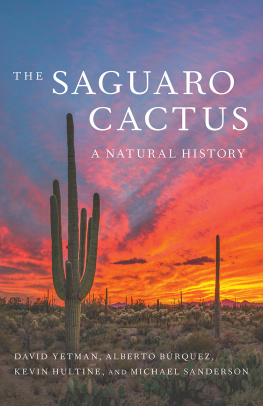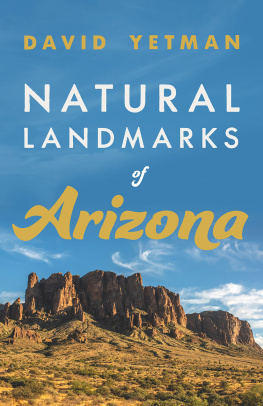David Yetman - The Saguaro Cactus: A Natural History
Here you can read online David Yetman - The Saguaro Cactus: A Natural History full text of the book (entire story) in english for free. Download pdf and epub, get meaning, cover and reviews about this ebook. year: 2020, publisher: University of Arizona Press, genre: Art. Description of the work, (preface) as well as reviews are available. Best literature library LitArk.com created for fans of good reading and offers a wide selection of genres:
Romance novel
Science fiction
Adventure
Detective
Science
History
Home and family
Prose
Art
Politics
Computer
Non-fiction
Religion
Business
Children
Humor
Choose a favorite category and find really read worthwhile books. Enjoy immersion in the world of imagination, feel the emotions of the characters or learn something new for yourself, make an fascinating discovery.
- Book:The Saguaro Cactus: A Natural History
- Author:
- Publisher:University of Arizona Press
- Genre:
- Year:2020
- Rating:4 / 5
- Favourites:Add to favourites
- Your mark:
- 80
- 1
- 2
- 3
- 4
- 5
The Saguaro Cactus: A Natural History: summary, description and annotation
We offer to read an annotation, description, summary or preface (depends on what the author of the book "The Saguaro Cactus: A Natural History" wrote himself). If you haven't found the necessary information about the book — write in the comments, we will try to find it.
David Yetman: author's other books
Who wrote The Saguaro Cactus: A Natural History? Find out the surname, the name of the author of the book and a list of all author's works by series.
The Saguaro Cactus: A Natural History — read online for free the complete book (whole text) full work
Below is the text of the book, divided by pages. System saving the place of the last page read, allows you to conveniently read the book "The Saguaro Cactus: A Natural History" online for free, without having to search again every time where you left off. Put a bookmark, and you can go to the page where you finished reading at any time.
Font size:
Interval:
Bookmark:

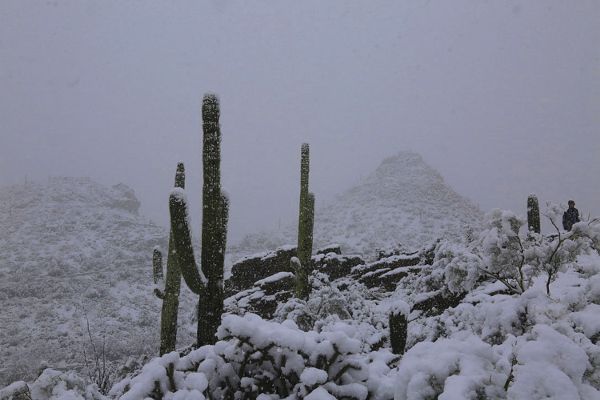
Gates Pass, Tucson Mountains, February 22, 2019. Photo by David Yetman.
The Southwest Center Series
Joseph C. Wilder, Editor
David Yetman, Alberto Brquez, Kevin Hultine, and Michael Sanderson
with Frank S. Crosswhite

The University of Arizona Press
www.uapress.arizona.edu
2020 by The Arizona Board of Regents
All rights reserved. Published 2020
ISBN-13: 978-0-8165-4004-4 (paper)
Cover design by Leigh McDonald
Cover photo: Picture Rocks Sunset by Jesse Jackson / JesseJ.media
Designed and typeset by Leigh McDonald in Fournier and Minion Pro, 10.25/14
Library of Congress Control Number: 2019952316
Printed in the United States of America
This paper meets the requirements of ANSI/NISO Z39.481992 (Permanence of Paper).
We dedicate this volume to the memory of our mentor and friend Raymond M. Turner, whose studies on the saguaro cactus were an inspiration and an unending source of information. His willingness to engage students, his magnanimous personality, and his profound understanding of the Sonoran Desert provided an unmatched influence in our thinking and in our writing.
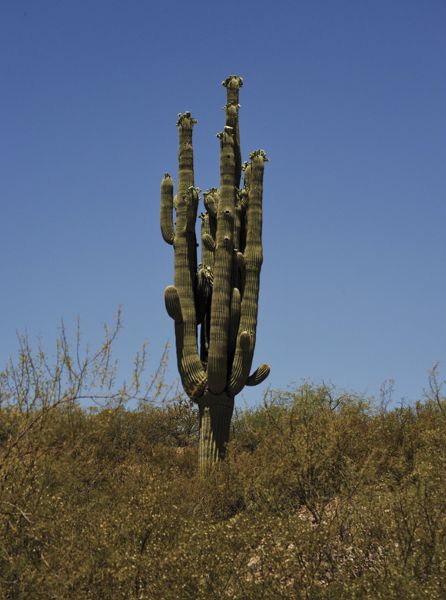
Figure 1.1 A rather old saguaro near Mammoth, Arizona, in the San Pedro Valley, a location of many old and large plants. The buds and flowers indicate that the photo was taken in late spring, probably late April or early May. The branch at the center has three cavities carved by Gila woodpeckers or gilded flickers. The highest of the three appears to be the most recent and may presage the breaking of the branch above that point. Other branches support hollows as well. The numerous branches and cavities indicate it is of great age. This individual is probably in the last decade or two of its life. Photo by David Yetman.
THE CANE MAKER
He made a cane from a saguaro rib so his wife
would walk the world with him, and so the rib,
its ancient flesh sloughed away, would rise
straight and steady beneath her delicate hand.
The rib walked beside her and remembered
the rain, the cactus wren, the white flowers,
the red fruitstheir seeds planning giants
to grace the desert skyline.
That night the rib dreamed itself whole again.
It appeared at dawn rooted through the floor,
busting through the roof into familiar blue
a forty-foot column of thorned water.
Everyday oak would have to do
store-bought, rubber tipped, merely useful.
A workable rib would come eventually.
The cane maker shelved his tools and waited.
NED MACKEY
I wish to acknowledge the special assistance provided by Janelle Weakly of the Arizona State Museum and Debra Colodner and Craig Ivanyi of the Arizona-Sonora Desert Museum.
DY
I wish to note the special assistance from the following individuals: Dario Copetti, Marty Wojciechowski, and Michelle McMahon.
MS
I wish to acknowledge the special assistance from the following individuals and institutions: Angelina Martnez-Yrzar, Enriquena Bustamante, Direccin General de Apoyos al Personal Acadmico-UNAM, and the Consortium for Arizona-Mexico Arid Environments (CAZMEX).
AB
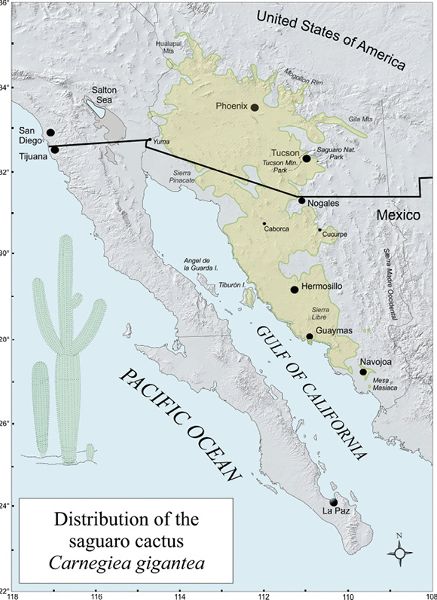
Map 1.1 The pale green color represents the distribution of the saguaro cactus. The region south of Guaymas is beyond the generally recognized limits of the Sonoran Desert, with a notable disjunct population on Mesa Masiaca. Note also the slight extensions into the state of California and the absence from Baja California. Map by Alberto Brquez.
David Yetman
As we approached the foot of the botanical mountain, I framed up a foolish question. I was about to say, Why are your fence posts so tall, and so irregular? But for once I wisely held my peace; and presently it was clear that all those seeming tall straight posts running up the mountain on the southern sky-line were giant cacti, without sidearms. They stood all over the plain, and climbed up all sides of the mountain.
William Hornaday, upon making his first visit to the Desert Laboratory on Tumamoc Hill in 1907
More amazing perhaps than any aspect of its biology is Mans emotional involvement with the saguarothe saguaro is a hero among plants. He has endowed it with human attributes and bestowed upon it affection and concern for its problems.
Scotty Steenbergh and Charles Lowe, Ecology of the Saguaro II
T he saguaro is one of the worlds most studied wild plant species, probably because of its charisma and ready accessibility, but also because, as a large cactus, it is decidedly different from plants more familiar to researchers. Virtually every aspect of its life and its place in cactus evolution has been minutely examined. The essays in this book bear witness to the ongoing fascination researchers find in the great cactus, as well as the plants unusual characteristics. There is simply no other plant like it in the United States, so instantly identifiable, so predictably located, and possessor of such a variety of distinct characteristics. It also has a national park dedicated to it, joining only the Joshua tree, the coastal redwood, and the sequoia in that honor. The vast literature concerning the saguaro is testimony to its prominence as a symbol, to the perceptions it inspires, its role in human society, and its role in desert ecology.
The saguaro, with its great size and characteristic shapeits arms stretching heavenward, its silhouette often resembling a humanhas become the emblem of the Sonoran Desert of southwestern Arizona. This is rightly so, for it is by far the largest and tallest cactus in the United States and our tallest desert plant as well. In this volume, we present a summary of current information about this, the deserts most noteworthy plant.
Saguaros occasionally reach 12 m (40 feet) in height, and individuals over 15 m (50 feet) tall appear from time to time. The record height is 23 m (78 feet), a well-known plant of a single stalk growing near Cave Creek, Arizona, which was toppled by winds in 1986. Photos of that plant are elusive, but it was clearly a very tall cactus, perhaps the tallest of any cactus ever recorded. While other cactus species may produce individuals taller than the average saguaro, none has been documented of that stupendous height. In 1907 William Hornaday reported a saguaro between 55 and 60 feet in height. He was leader of a 1907 scientific expedition to Pinacate Volcanic Range in Mexico near the border with southwestern Arizona and was in the company of distinguished researchers. The saguaros sole competitor for tallness in the deserts of the United States is the Joshua tree (Yucca brevifolia), a native of the Mohave Desert, a yucca that only rarely reaches 9 m (30 feet) in height.
Next pageFont size:
Interval:
Bookmark:
Similar books «The Saguaro Cactus: A Natural History»
Look at similar books to The Saguaro Cactus: A Natural History. We have selected literature similar in name and meaning in the hope of providing readers with more options to find new, interesting, not yet read works.
Discussion, reviews of the book The Saguaro Cactus: A Natural History and just readers' own opinions. Leave your comments, write what you think about the work, its meaning or the main characters. Specify what exactly you liked and what you didn't like, and why you think so.

